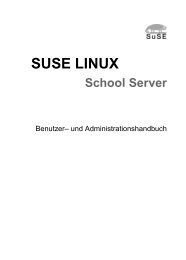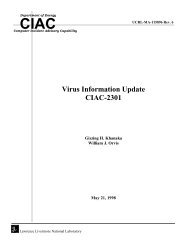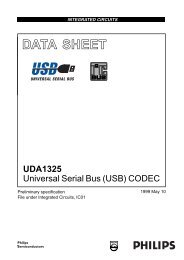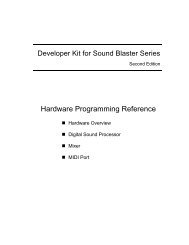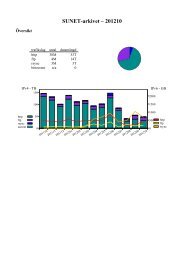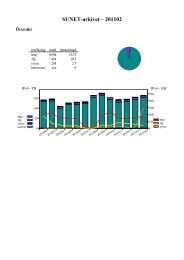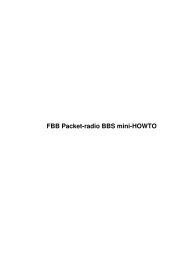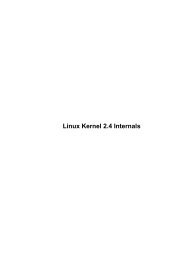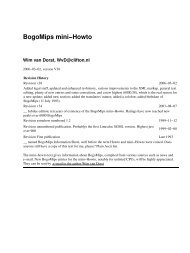Linux IP Masquerade HOWTO - The Linux Documentation Project
Linux IP Masquerade HOWTO - The Linux Documentation Project
Linux IP Masquerade HOWTO - The Linux Documentation Project
You also want an ePaper? Increase the reach of your titles
YUMPU automatically turns print PDFs into web optimized ePapers that Google loves.
== MODEMs: ppp and/or slip<br />
== WANs: T1, T3, ISDN, etc.<br />
== ISDN: for internal ISDN modems<br />
[ File systems ]<br />
== Non−MASQ options skipped<br />
== (Quota, ISO9660, Codepages, NTFS, etc )<br />
* /proc filesystem support (CONFIG_PROC_FS) [Y/n/?]<br />
− YES: Required to dynamically configure the <strong>Linux</strong> forwarding<br />
and NATing systems<br />
[ Character devices ]<br />
== Non−MASQ options skipped<br />
== (multi−port serial, parallel, mice, Ftape, Sound, etc. )<br />
== Don't forget to compile in serial port support for modem users<br />
== Don't forget to compile in mouse support<br />
So go ahead and "exit" and you should be prompted to save your config.<br />
NOTE: <strong>The</strong>se are only components for <strong>IP</strong> <strong>Masquerade</strong> functionality. You may need to also select additional<br />
options to match your specific network and hardware setup.<br />
• Now compile the kernel (make dep; make clean; make bzImage; make modules; make<br />
modules_install) , etc. Again, it is beyond the scope of this <strong>HOWTO</strong> if you have problems compiling<br />
your kernel. Please see Section 2.8 for URLs to the KERNEL howto, etc.<br />
• You will then have move over the kernel binary, update your bootloader (LILO, Grub, etc.), and<br />
reboot. If you have questions about kernel compiling, I highly recommend to consult some of the<br />
URLs above in this section.<br />
3.3. Assigning Private Network <strong>IP</strong> Addresses to the Internal<br />
LAN<br />
Since all INTERNAL MASQed machines should NOT have official Internet assigned addressees, there must<br />
be a specific and accepted way to allocate addresses to those machines without conflicting with anyone else's<br />
Internet address.<br />
From the original <strong>IP</strong> <strong>Masquerade</strong> FAQ:<br />
RFC 1918 is the official document on which <strong>IP</strong> addresses are to be used in a non−connected or "private"<br />
network. <strong>The</strong>re are 3 blocks of numbers set aside specifically for this purpose.<br />
Section 3: Private Address Space<br />
<strong>Linux</strong> <strong>IP</strong> <strong>Masquerade</strong> <strong>HOWTO</strong><br />
<strong>The</strong> Internet Assigned Numbers Authority (IANA) has reserved the<br />
following three blocks of the <strong>IP</strong> address space for private networks:<br />
10.0.0.0 − 10.255.255.255<br />
172.16.0.0 − 172.31.255.255<br />
192.168.0.0 − 192.168.255.255<br />
Chapter 3. Setting Up <strong>IP</strong> <strong>Masquerade</strong> 35



